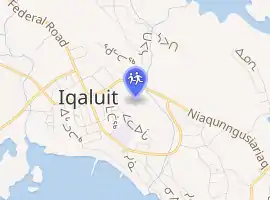Inuksuk High School
Inuksuk High School is the high school of Iqaluit, the capital of the Canadian territory of Nunavut.
| Inuksuk High School | |
|---|---|
| Address | |

| |
Box 487 , , Canada | |
| Coordinates | 63°44′57″N 68°30′50″W |
| Information | |
| School type | Public Secondary School |
| Established | 1971[1] |
| School board | Qikiqtani School Operations |
| Superintendent | Trudy Pettigrew (Executive Director)[2] |
| Principal | Tim Hoyt |
| Staff | 43[3] |
| Grades | 9–12 |
| Enrollment | 410[3] |
| Language | Inuktitut and English |
| Colour(s) | Blue and black |
| Team name | Iqaluit Huskies |
History
The school opened in late 1971 as the Gordon Robertson Educational Centre with 278 students and 28 teachers.[1] Don King was the first principal.[1] The school was built by two companies, Maurice Carrier Inc. and Wilfrid Legars Inc., both of Sainte-Foy, Quebec, at a cost of $3.3 million.[4][1] Canadian Industries Limited built the school's exterior walls from prefabricated glass-fiber reinforced plastic, a light-weight material that would reduce shipping costs.[4][5] The panels were designed to withstand winds of 100 miles per hour (161 km/h), which sometimes occur in the area.[4] Exterior windows were made of three layers of glass, similar to the type used on airplanes, in order to provide thermal insulation.[4]
Before the school was built, students were sent to Churchill, Manitoba, for high school.[6][7]
References
- Hume, Steve (October 12, 1971). "North School Runs Into Snag". Edmonton Journal. p. 39.
- "General". Qikiqtani School Operations. Pond Inlet. Archived from the original on 17 February 2010. Retrieved 7 July 2020.
- "Inuksuk High School". Nunavut Teacher Induction Program. Retrieved October 28, 2020.
- "Indian Students Get New School With Radical Design, Concept". Calgary Herald. August 30, 1969. p. 53.
- "CIL supplies plastic panels". National Post (Toronto, Ontario). September 5, 1970. p. 30.
- "Eskimos Try Adapting to Urbanization". News-Journal (Mansfield, Ohio, USA). April 12, 1970. p. 7.
- "Federal Hostel at Frobisher Bay (Ukkivik Student Residence)". National Centre for Truth and Reconciliation. University of Manitoba. Retrieved July 7, 2020.